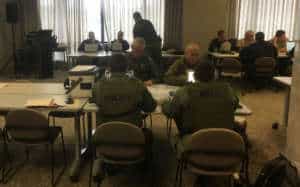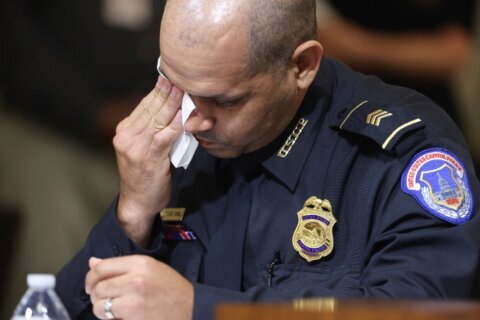GAITHERSBURG, Md. — A woman suffering from mental illness has gone missing in Montgomery County. Teams of officers from other area police departments have established search grids in her case, gathered around tables in a conference room at Montgomery County’s police headquarters.
The woman’s case is real and was used Monday to train officers from neighboring departments on locating missing people and also to familiarize them with Montgomery County’s response to these sorts of cases.
Environments and personnel may differ, but being familiar with how neighboring departments operate can help law enforcement better work together, said Officer John Greene, an instructor and a K-9 handler with Montgomery County police for more than 30 years.
“If we are speaking the same language, it helps with the investigations of the cases; it helps with translating the cases from one jurisdiction to another,” Greene said.
This particular case is also one of more than 3,000 missing persons cases the Montgomery County Police Department receives in a year.

At one table on Monday, officers from the Maryland Natural Resources Police looked at maps on computers and discussed what their strategy would be in searching for the woman in the case.
“The good thing about this training is that it brings everyone together and says that we all have this common goal and a common task that we are trying to complete,” said Sgt. Ben Lillard with the state’s natural resources police.
At the end of the class, each team of officers must decide if they have found the person with the information provided or if they must call off the search. The results are then examined and discussed between the teams in the room, Greene said, and many times, even the teachers learn because the teams are looking into their cases.
“It helps us grow and helps us learn,” Greene said.
Officer Jason Huggins, a search manager for Montgomery County police, added that jurisdictions around the D.C. area need to work together because, with many mass transit options, missing people can quickly make it out of the area.
For those who are believed to be on foot, it still doesn’t take long for a search for them to expand. “With the speed a person can walk — we’ll say 2 miles an hour — within six to eight hours of a person going missing, the entire county is our search area,” Huggins said.
The training can also help with finding people suffering from other conditions such as dementia, who may have wandered away from home, and in cases where someone mysteriously disappears, or if a multi-jurisdiction search is on for a suspect in a crime.
For those in the class, Huggins said it is also a chance for the officers from all the different departments to network and get to know one another before they are under the pressure of an active case. Attendees like Sgt. Chris Cusmano of the Charles County Sheriff’s Office said it’s essential all departments cooperate with one another.
“To cover a large area or an extended search that may last hours or days is nearly impossible to do for an agency completely on their own without relying on other agencies to help out,” Cusmano said.








